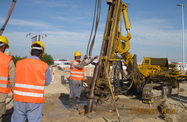Large-scale overseas investments, combined with increased state spending on infrastructure projects, has resulted in the Jordanian construction industry shifting its focus from the capital Amman, which had long been the centre of building activity, to the port city of Aqaba.
The cornerstone of Aqaba’s recent surge in construction is the Marsa Zayed project, a $10bn mixed-use development being built along the coast on a 3.2m-sq-metre site, including 2 km of waterfront. The first stage of the development – Al Raha Village – comprises 260 apartments, almost 200 townhouses, retail space, recreational areas and a community centre. The initial phase is expected to be complete by 2015, according to Abu Dhabi-based developer Al Maabar.
When the Marsa Zayed development is finished in the second half of the decade, it will have eight hotels with 3000 rooms, more than 30,000 residential units and at least one large marina.
Meanwhile, Saraya Aqaba, a $1bn, mixed–use beachfront project, commenced development in 2010 and will comprise a wide variety of residential units, five high-end and two boutique hotels, and numerous retail, leisure and business facilities. Funding issues have caused delays but negotiations with a new contractor have begun and construction work is expected to start in the coming months.
Another high-end development located on the waterfront is the Ayla Oasis. Spread over 432 ha, the first phase of the project, which is expected to be complete by 2015, will include 256 residential units; 419 hotel rooms; an 18-hole golf course designed by Greg Norman, featuring man-made lagoons (already completed); and a Marina Village, with 202 moorings.
To accommodate the redevelopment of the city, Aqaba’s current port facilities are being gradually moved to a new port close to the Saudi Arabian border. The current port’s phosphate terminal is due to be relocated to the new maritime centre by 2013. The new port will consist of four deepwater berths, following the construction of storage facilities, ramps and supporting infrastructure, with the work due to be completed by 2014.
Meanwhile, the Aqaba Development Corporation (ADC) called for tenders for the construction of new oil and gas terminals at the end of 2012. Work on the oil terminal is due to begin in early 2013, and the government is hoping a liquefied natural gas terminal, which it will use to import gas from Qatar and other sources to shore up imports, will be operational by 2014.
Construction of the oil terminal could take on greater importance if Amman and Baghdad follow through with a plan to build a pipeline to transport Iraqi crude to the port for export, with the proposal having been given the backing of the two governments during a meeting of senior officials in late December 2012.
While large-scale developments, such as Marsa Zayed, Ayla Oasis and Saraya Aqaba, are aimed at the higher end of the residential market, an expansion of the population, which the ADC estimates will increase from the current level of 100,000 to 250,000 over the next 10 years, will require a broader range of housing, along with commercial and retail space, to meet the needs of workers and businesses attracted to the city by the forecast economic growth.
Over the coming decade, it is likely there will be a number of new urban projects launched in and around Aqaba, and while they may not have the same profile or budgets as the top-end developments, the infrastructure and construction components should provide opportunities for both investors and contractors. Combined with the existing development projects, the construction sector in Jordan should see a healthy stream of orders coming onto their books for some time to come.

